Strategies for Supporting Culturally Diverse Students: A Report
VerifiedAdded on 2023/04/07
|5
|1293
|58
Report
AI Summary
This report addresses the significance of cultural diversity in early childhood education, emphasizing the need for inclusive learning environments. It highlights the diverse cultural experiences of students and staff, focusing on strategies to meet the educational and prosperity needs of students from various linguistic backgrounds. The report examines the implications for students, schools, and teaching, emphasizing the importance of establishing inclusion, developing positive attitudes, augmenting meaning, and nurturing confidence. It details a range of teaching, learning, and assessment strategies that respond to diverse socio-cultural contexts and varied learning needs, including learning about students, interviewing them, integrating relevant word problems, using student terminology, bringing in celebrity speakers, delivering various forms of content, gamifying lessons, calling on each student, using media to portray cultures positively, and proposing project ideas. These strategies aim to create a culturally responsive classroom that supports student success and engagement.
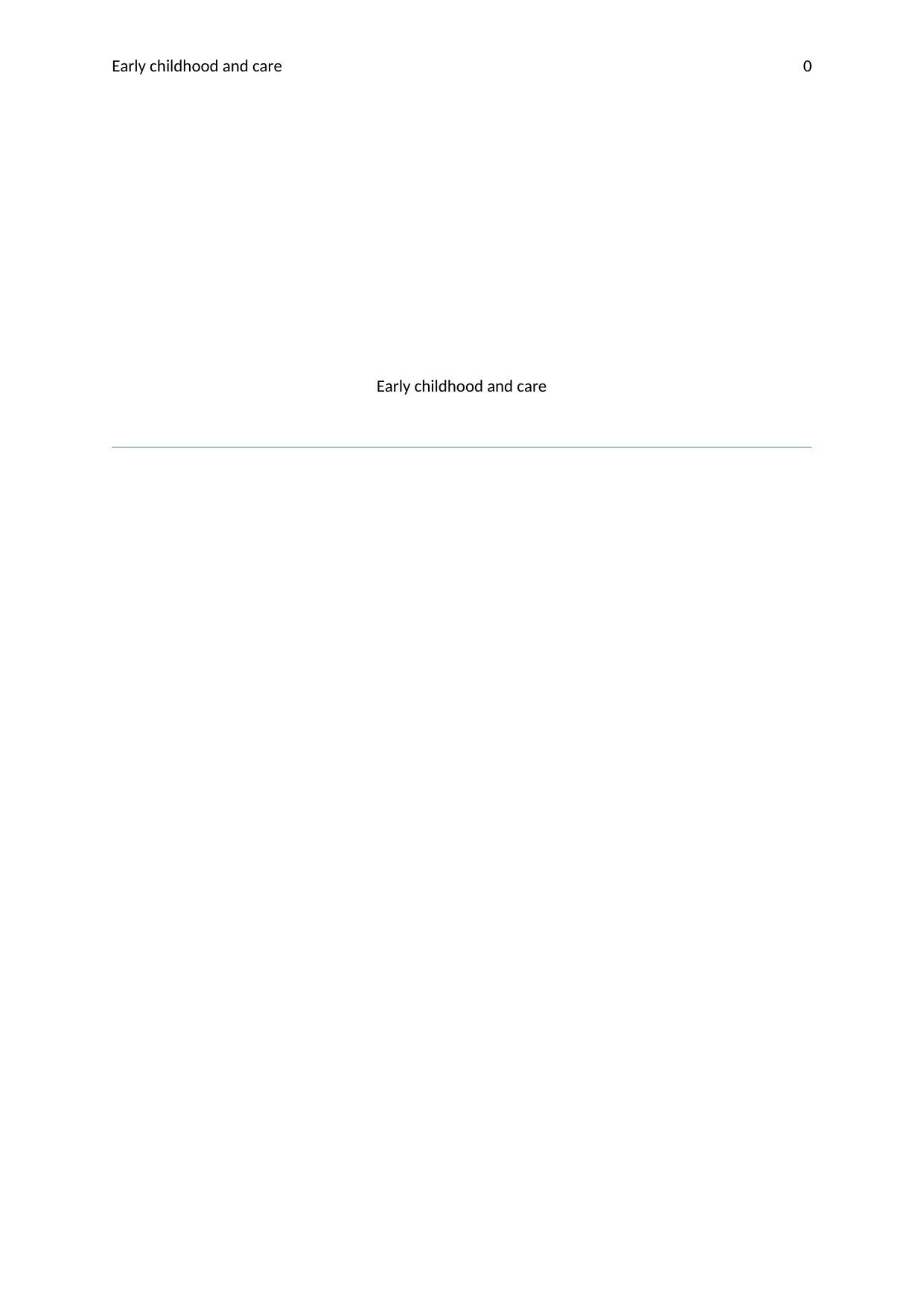
Early childhood and care 0
Early childhood and care
Early childhood and care
Paraphrase This Document
Need a fresh take? Get an instant paraphrase of this document with our AI Paraphraser
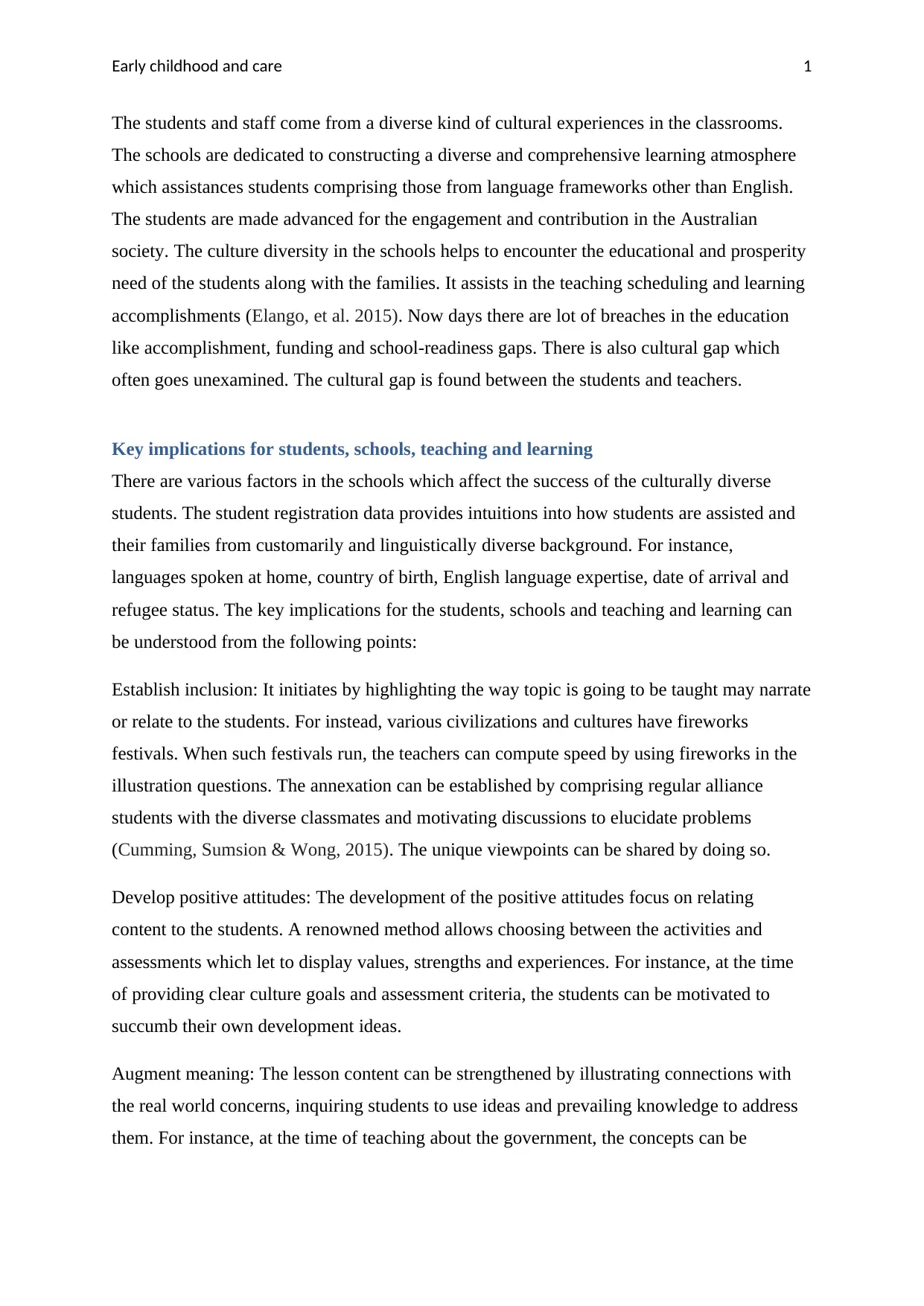
Early childhood and care 1
The students and staff come from a diverse kind of cultural experiences in the classrooms.
The schools are dedicated to constructing a diverse and comprehensive learning atmosphere
which assistances students comprising those from language frameworks other than English.
The students are made advanced for the engagement and contribution in the Australian
society. The culture diversity in the schools helps to encounter the educational and prosperity
need of the students along with the families. It assists in the teaching scheduling and learning
accomplishments (Elango, et al. 2015). Now days there are lot of breaches in the education
like accomplishment, funding and school-readiness gaps. There is also cultural gap which
often goes unexamined. The cultural gap is found between the students and teachers.
Key implications for students, schools, teaching and learning
There are various factors in the schools which affect the success of the culturally diverse
students. The student registration data provides intuitions into how students are assisted and
their families from customarily and linguistically diverse background. For instance,
languages spoken at home, country of birth, English language expertise, date of arrival and
refugee status. The key implications for the students, schools and teaching and learning can
be understood from the following points:
Establish inclusion: It initiates by highlighting the way topic is going to be taught may narrate
or relate to the students. For instead, various civilizations and cultures have fireworks
festivals. When such festivals run, the teachers can compute speed by using fireworks in the
illustration questions. The annexation can be established by comprising regular alliance
students with the diverse classmates and motivating discussions to elucidate problems
(Cumming, Sumsion & Wong, 2015). The unique viewpoints can be shared by doing so.
Develop positive attitudes: The development of the positive attitudes focus on relating
content to the students. A renowned method allows choosing between the activities and
assessments which let to display values, strengths and experiences. For instance, at the time
of providing clear culture goals and assessment criteria, the students can be motivated to
succumb their own development ideas.
Augment meaning: The lesson content can be strengthened by illustrating connections with
the real world concerns, inquiring students to use ideas and prevailing knowledge to address
them. For instance, at the time of teaching about the government, the concepts can be
The students and staff come from a diverse kind of cultural experiences in the classrooms.
The schools are dedicated to constructing a diverse and comprehensive learning atmosphere
which assistances students comprising those from language frameworks other than English.
The students are made advanced for the engagement and contribution in the Australian
society. The culture diversity in the schools helps to encounter the educational and prosperity
need of the students along with the families. It assists in the teaching scheduling and learning
accomplishments (Elango, et al. 2015). Now days there are lot of breaches in the education
like accomplishment, funding and school-readiness gaps. There is also cultural gap which
often goes unexamined. The cultural gap is found between the students and teachers.
Key implications for students, schools, teaching and learning
There are various factors in the schools which affect the success of the culturally diverse
students. The student registration data provides intuitions into how students are assisted and
their families from customarily and linguistically diverse background. For instance,
languages spoken at home, country of birth, English language expertise, date of arrival and
refugee status. The key implications for the students, schools and teaching and learning can
be understood from the following points:
Establish inclusion: It initiates by highlighting the way topic is going to be taught may narrate
or relate to the students. For instead, various civilizations and cultures have fireworks
festivals. When such festivals run, the teachers can compute speed by using fireworks in the
illustration questions. The annexation can be established by comprising regular alliance
students with the diverse classmates and motivating discussions to elucidate problems
(Cumming, Sumsion & Wong, 2015). The unique viewpoints can be shared by doing so.
Develop positive attitudes: The development of the positive attitudes focus on relating
content to the students. A renowned method allows choosing between the activities and
assessments which let to display values, strengths and experiences. For instance, at the time
of providing clear culture goals and assessment criteria, the students can be motivated to
succumb their own development ideas.
Augment meaning: The lesson content can be strengthened by illustrating connections with
the real world concerns, inquiring students to use ideas and prevailing knowledge to address
them. For instance, at the time of teaching about the government, the concepts can be
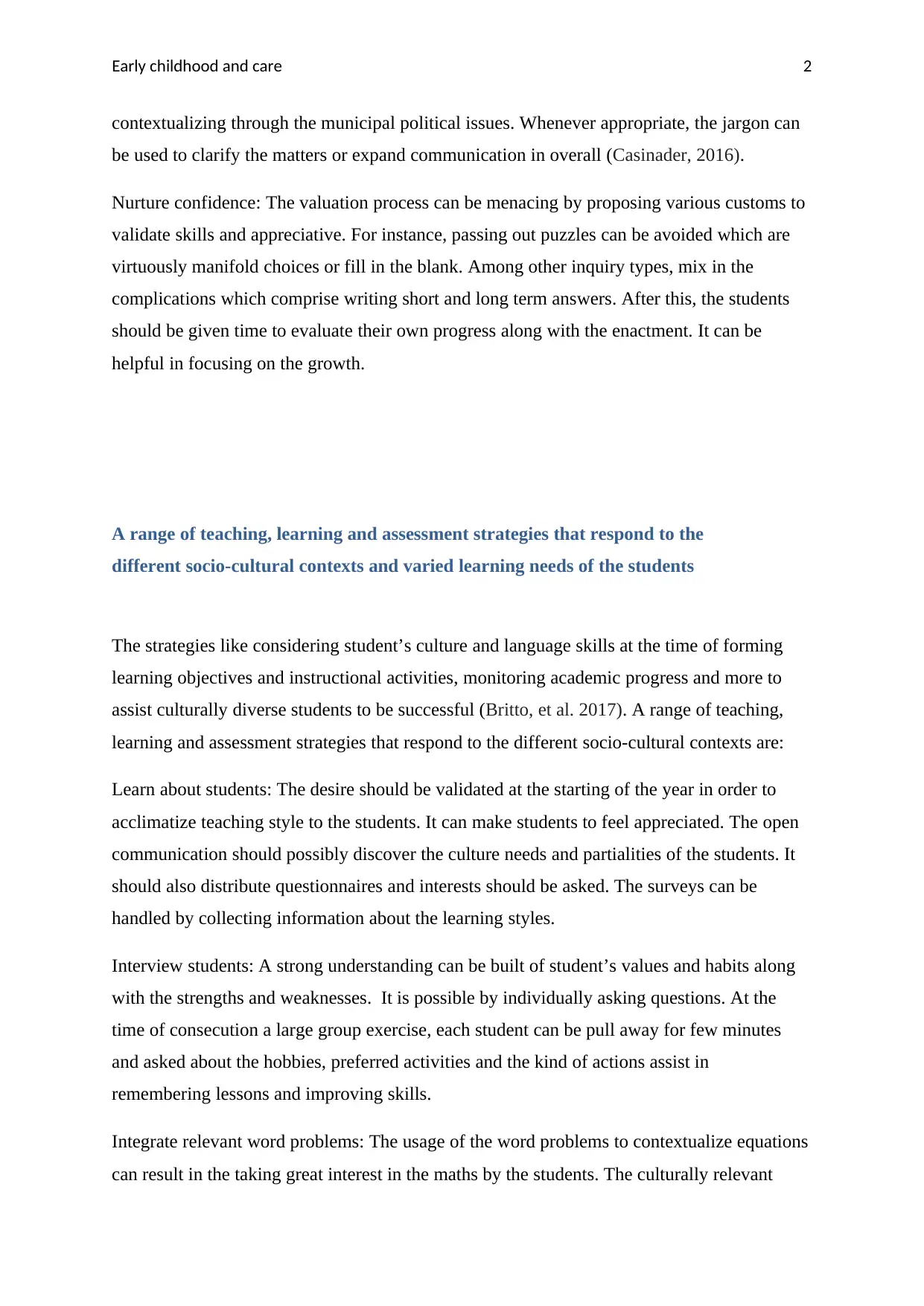
Early childhood and care 2
contextualizing through the municipal political issues. Whenever appropriate, the jargon can
be used to clarify the matters or expand communication in overall (Casinader, 2016).
Nurture confidence: The valuation process can be menacing by proposing various customs to
validate skills and appreciative. For instance, passing out puzzles can be avoided which are
virtuously manifold choices or fill in the blank. Among other inquiry types, mix in the
complications which comprise writing short and long term answers. After this, the students
should be given time to evaluate their own progress along with the enactment. It can be
helpful in focusing on the growth.
A range of teaching, learning and assessment strategies that respond to the
different socio-cultural contexts and varied learning needs of the students
The strategies like considering student’s culture and language skills at the time of forming
learning objectives and instructional activities, monitoring academic progress and more to
assist culturally diverse students to be successful (Britto, et al. 2017). A range of teaching,
learning and assessment strategies that respond to the different socio-cultural contexts are:
Learn about students: The desire should be validated at the starting of the year in order to
acclimatize teaching style to the students. It can make students to feel appreciated. The open
communication should possibly discover the culture needs and partialities of the students. It
should also distribute questionnaires and interests should be asked. The surveys can be
handled by collecting information about the learning styles.
Interview students: A strong understanding can be built of student’s values and habits along
with the strengths and weaknesses. It is possible by individually asking questions. At the
time of consecution a large group exercise, each student can be pull away for few minutes
and asked about the hobbies, preferred activities and the kind of actions assist in
remembering lessons and improving skills.
Integrate relevant word problems: The usage of the word problems to contextualize equations
can result in the taking great interest in the maths by the students. The culturally relevant
contextualizing through the municipal political issues. Whenever appropriate, the jargon can
be used to clarify the matters or expand communication in overall (Casinader, 2016).
Nurture confidence: The valuation process can be menacing by proposing various customs to
validate skills and appreciative. For instance, passing out puzzles can be avoided which are
virtuously manifold choices or fill in the blank. Among other inquiry types, mix in the
complications which comprise writing short and long term answers. After this, the students
should be given time to evaluate their own progress along with the enactment. It can be
helpful in focusing on the growth.
A range of teaching, learning and assessment strategies that respond to the
different socio-cultural contexts and varied learning needs of the students
The strategies like considering student’s culture and language skills at the time of forming
learning objectives and instructional activities, monitoring academic progress and more to
assist culturally diverse students to be successful (Britto, et al. 2017). A range of teaching,
learning and assessment strategies that respond to the different socio-cultural contexts are:
Learn about students: The desire should be validated at the starting of the year in order to
acclimatize teaching style to the students. It can make students to feel appreciated. The open
communication should possibly discover the culture needs and partialities of the students. It
should also distribute questionnaires and interests should be asked. The surveys can be
handled by collecting information about the learning styles.
Interview students: A strong understanding can be built of student’s values and habits along
with the strengths and weaknesses. It is possible by individually asking questions. At the
time of consecution a large group exercise, each student can be pull away for few minutes
and asked about the hobbies, preferred activities and the kind of actions assist in
remembering lessons and improving skills.
Integrate relevant word problems: The usage of the word problems to contextualize equations
can result in the taking great interest in the maths by the students. The culturally relevant
⊘ This is a preview!⊘
Do you want full access?
Subscribe today to unlock all pages.

Trusted by 1+ million students worldwide
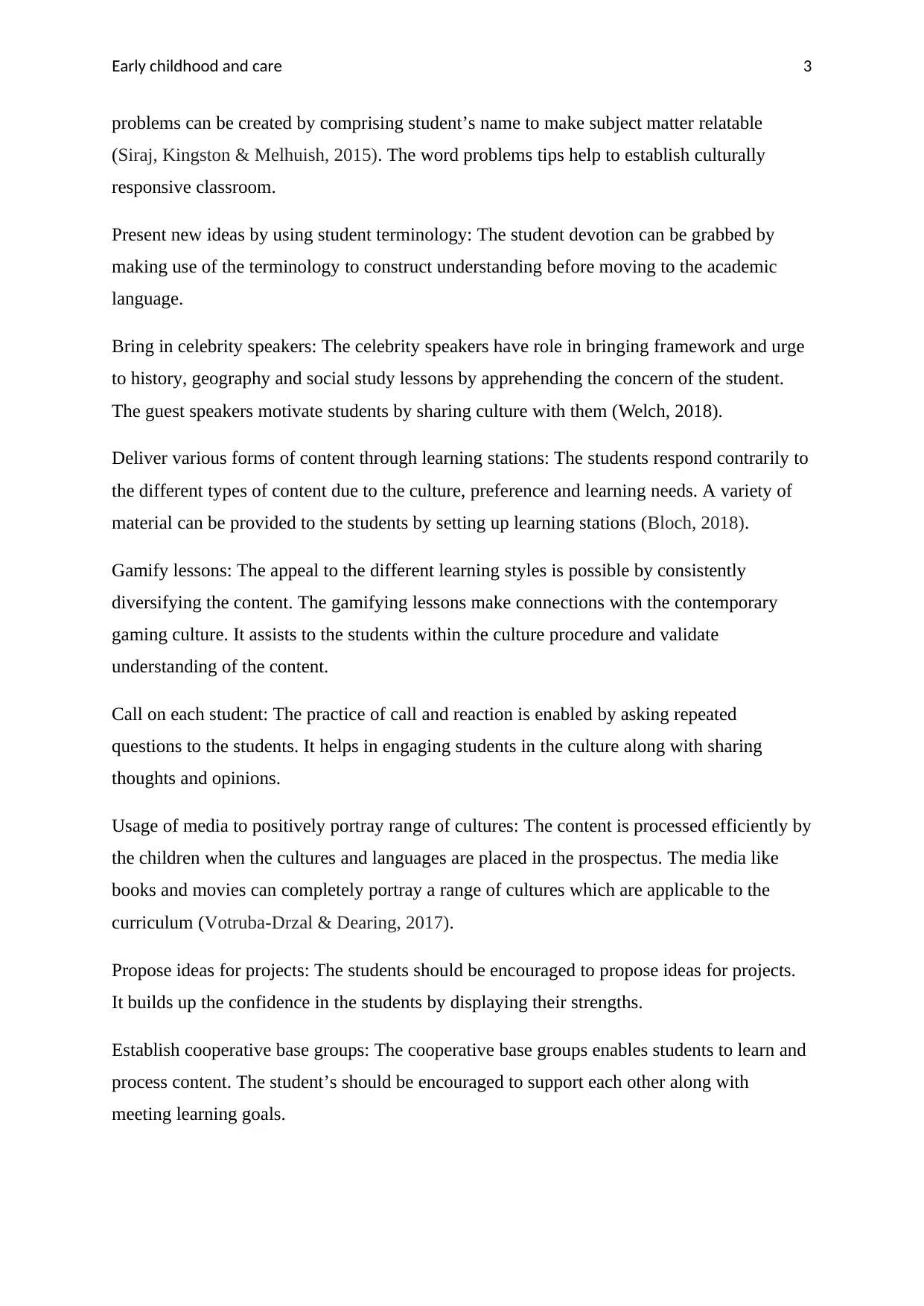
Early childhood and care 3
problems can be created by comprising student’s name to make subject matter relatable
(Siraj, Kingston & Melhuish, 2015). The word problems tips help to establish culturally
responsive classroom.
Present new ideas by using student terminology: The student devotion can be grabbed by
making use of the terminology to construct understanding before moving to the academic
language.
Bring in celebrity speakers: The celebrity speakers have role in bringing framework and urge
to history, geography and social study lessons by apprehending the concern of the student.
The guest speakers motivate students by sharing culture with them (Welch, 2018).
Deliver various forms of content through learning stations: The students respond contrarily to
the different types of content due to the culture, preference and learning needs. A variety of
material can be provided to the students by setting up learning stations (Bloch, 2018).
Gamify lessons: The appeal to the different learning styles is possible by consistently
diversifying the content. The gamifying lessons make connections with the contemporary
gaming culture. It assists to the students within the culture procedure and validate
understanding of the content.
Call on each student: The practice of call and reaction is enabled by asking repeated
questions to the students. It helps in engaging students in the culture along with sharing
thoughts and opinions.
Usage of media to positively portray range of cultures: The content is processed efficiently by
the children when the cultures and languages are placed in the prospectus. The media like
books and movies can completely portray a range of cultures which are applicable to the
curriculum (Votruba-Drzal & Dearing, 2017).
Propose ideas for projects: The students should be encouraged to propose ideas for projects.
It builds up the confidence in the students by displaying their strengths.
Establish cooperative base groups: The cooperative base groups enables students to learn and
process content. The student’s should be encouraged to support each other along with
meeting learning goals.
problems can be created by comprising student’s name to make subject matter relatable
(Siraj, Kingston & Melhuish, 2015). The word problems tips help to establish culturally
responsive classroom.
Present new ideas by using student terminology: The student devotion can be grabbed by
making use of the terminology to construct understanding before moving to the academic
language.
Bring in celebrity speakers: The celebrity speakers have role in bringing framework and urge
to history, geography and social study lessons by apprehending the concern of the student.
The guest speakers motivate students by sharing culture with them (Welch, 2018).
Deliver various forms of content through learning stations: The students respond contrarily to
the different types of content due to the culture, preference and learning needs. A variety of
material can be provided to the students by setting up learning stations (Bloch, 2018).
Gamify lessons: The appeal to the different learning styles is possible by consistently
diversifying the content. The gamifying lessons make connections with the contemporary
gaming culture. It assists to the students within the culture procedure and validate
understanding of the content.
Call on each student: The practice of call and reaction is enabled by asking repeated
questions to the students. It helps in engaging students in the culture along with sharing
thoughts and opinions.
Usage of media to positively portray range of cultures: The content is processed efficiently by
the children when the cultures and languages are placed in the prospectus. The media like
books and movies can completely portray a range of cultures which are applicable to the
curriculum (Votruba-Drzal & Dearing, 2017).
Propose ideas for projects: The students should be encouraged to propose ideas for projects.
It builds up the confidence in the students by displaying their strengths.
Establish cooperative base groups: The cooperative base groups enables students to learn and
process content. The student’s should be encouraged to support each other along with
meeting learning goals.
Paraphrase This Document
Need a fresh take? Get an instant paraphrase of this document with our AI Paraphraser
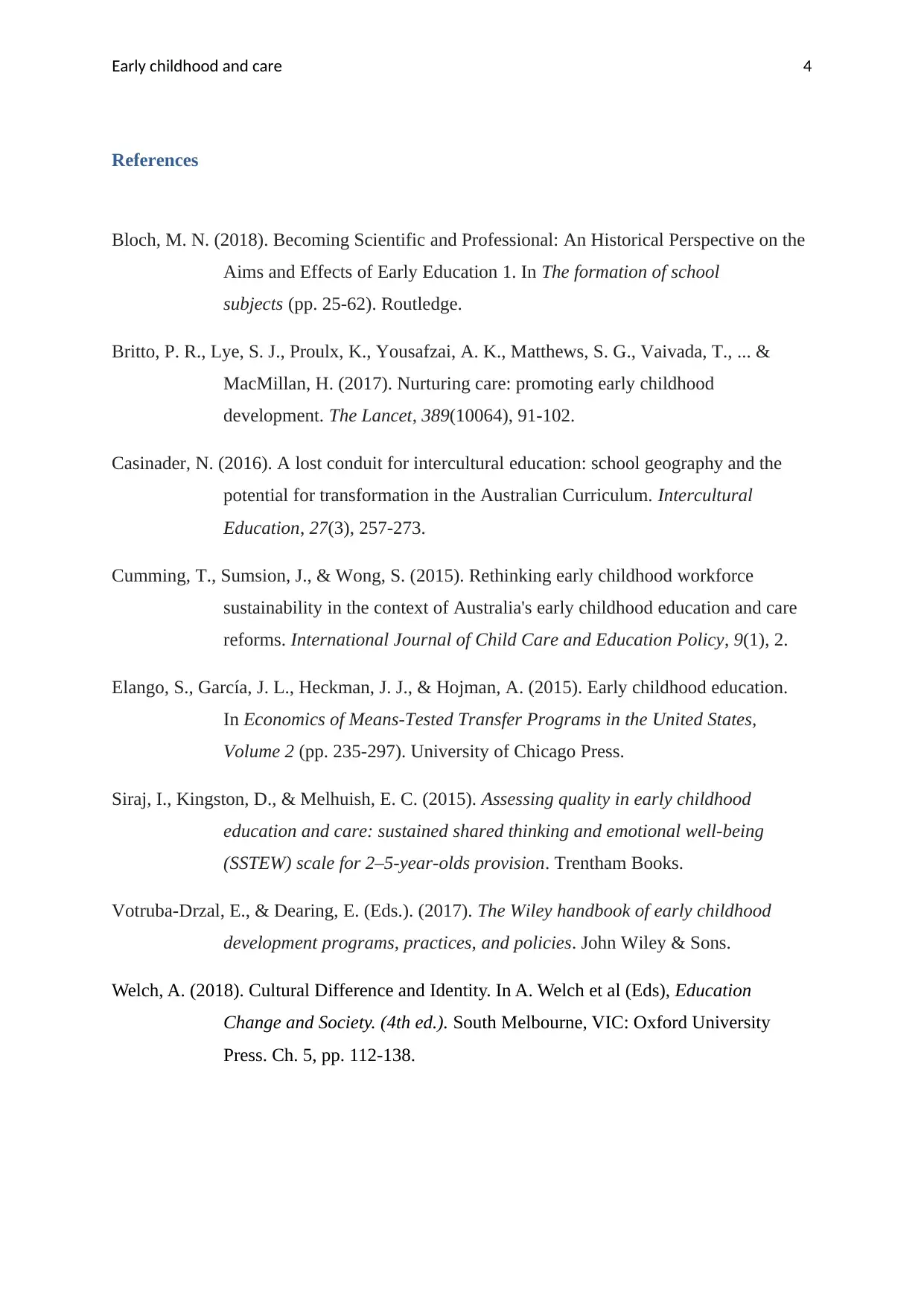
Early childhood and care 4
References
Bloch, M. N. (2018). Becoming Scientific and Professional: An Historical Perspective on the
Aims and Effects of Early Education 1. In The formation of school
subjects (pp. 25-62). Routledge.
Britto, P. R., Lye, S. J., Proulx, K., Yousafzai, A. K., Matthews, S. G., Vaivada, T., ... &
MacMillan, H. (2017). Nurturing care: promoting early childhood
development. The Lancet, 389(10064), 91-102.
Casinader, N. (2016). A lost conduit for intercultural education: school geography and the
potential for transformation in the Australian Curriculum. Intercultural
Education, 27(3), 257-273.
Cumming, T., Sumsion, J., & Wong, S. (2015). Rethinking early childhood workforce
sustainability in the context of Australia's early childhood education and care
reforms. International Journal of Child Care and Education Policy, 9(1), 2.
Elango, S., García, J. L., Heckman, J. J., & Hojman, A. (2015). Early childhood education.
In Economics of Means-Tested Transfer Programs in the United States,
Volume 2 (pp. 235-297). University of Chicago Press.
Siraj, I., Kingston, D., & Melhuish, E. C. (2015). Assessing quality in early childhood
education and care: sustained shared thinking and emotional well-being
(SSTEW) scale for 2–5-year-olds provision. Trentham Books.
Votruba-Drzal, E., & Dearing, E. (Eds.). (2017). The Wiley handbook of early childhood
development programs, practices, and policies. John Wiley & Sons.
Welch, A. (2018). Cultural Difference and Identity. In A. Welch et al (Eds), Education
Change and Society. (4th ed.). South Melbourne, VIC: Oxford University
Press. Ch. 5, pp. 112-138.
References
Bloch, M. N. (2018). Becoming Scientific and Professional: An Historical Perspective on the
Aims and Effects of Early Education 1. In The formation of school
subjects (pp. 25-62). Routledge.
Britto, P. R., Lye, S. J., Proulx, K., Yousafzai, A. K., Matthews, S. G., Vaivada, T., ... &
MacMillan, H. (2017). Nurturing care: promoting early childhood
development. The Lancet, 389(10064), 91-102.
Casinader, N. (2016). A lost conduit for intercultural education: school geography and the
potential for transformation in the Australian Curriculum. Intercultural
Education, 27(3), 257-273.
Cumming, T., Sumsion, J., & Wong, S. (2015). Rethinking early childhood workforce
sustainability in the context of Australia's early childhood education and care
reforms. International Journal of Child Care and Education Policy, 9(1), 2.
Elango, S., García, J. L., Heckman, J. J., & Hojman, A. (2015). Early childhood education.
In Economics of Means-Tested Transfer Programs in the United States,
Volume 2 (pp. 235-297). University of Chicago Press.
Siraj, I., Kingston, D., & Melhuish, E. C. (2015). Assessing quality in early childhood
education and care: sustained shared thinking and emotional well-being
(SSTEW) scale for 2–5-year-olds provision. Trentham Books.
Votruba-Drzal, E., & Dearing, E. (Eds.). (2017). The Wiley handbook of early childhood
development programs, practices, and policies. John Wiley & Sons.
Welch, A. (2018). Cultural Difference and Identity. In A. Welch et al (Eds), Education
Change and Society. (4th ed.). South Melbourne, VIC: Oxford University
Press. Ch. 5, pp. 112-138.
1 out of 5
Related Documents
Your All-in-One AI-Powered Toolkit for Academic Success.
+13062052269
info@desklib.com
Available 24*7 on WhatsApp / Email
![[object Object]](/_next/static/media/star-bottom.7253800d.svg)
Unlock your academic potential
Copyright © 2020–2025 A2Z Services. All Rights Reserved. Developed and managed by ZUCOL.




